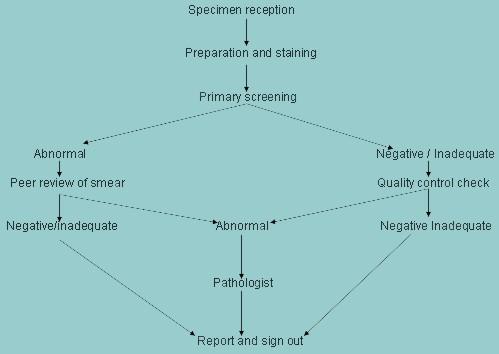This content is also available in:
English
Español
Čeština
Magyar
Polski
Concetto di garanzia di qualità, controllo di qualità e standards di qualità
Garanzia di qualità = I processi che costitutiscono il controllo di qualità vengono valutati in un sistema che accerti un sicuro altro standard della prestazione.
Controllo di qualità = La serie di provvedimenti indicate per accertare l’accuratezza dell’ interpretazione e della refertazione degli strisci cervicali.
Standards di qualità= I livelli di prestazione del laboratorio confrontati con le prestazioni locali , nazionali e internazionali per far risaltare la buona citologia.
I vari tipi di garanzia di qualità
I sistemi per la garanzia di qualità possono essere interni od esterni:
- Sistemi Interni per la garanzia di qualità (IQA) sono applicati dal laboratrio sulla base giornaliera di regolari controlli effetuati sui dati ottenuti e sulla introduzione di screening consecutivi.
- Sistemi Esterni per la garanzia di qualità (EQA) sono applicati da un organismo esterno regolatore es. accerditamenti, scheni per testare la competenza.

Internal quality assurance (IQA) measures to be taken on a daily basis
| Errors encountered | IQA measures |
|---|---|
| Specimen reception | |
| Errors at the point of reception are usually due to mismatching of smears and request forms. |
|
| Specimen processing | |
| Poor quality staining and fixation is the single most likely cause of errors of reporting cervical smears. |
|
| Specimen interpretation | |
| The commonest error is false negative reporting |
|
L’analisi degli strisci citologici è un compito ripetitivo che richiede capacità di intense concentrazione da parte del lettore a cui si richiede di individuare un relative piccolo numero di cellule atipiche fra migliaia di cellule epitelialai normali all’interno dello striscio. Per questo motivo il rischio di un referto falso negative è alto. Le misure che accertano la garanzia della qualità riducono il rischio di un referto falso negativo devono essere adottate in ogni laboratorio citologico.

